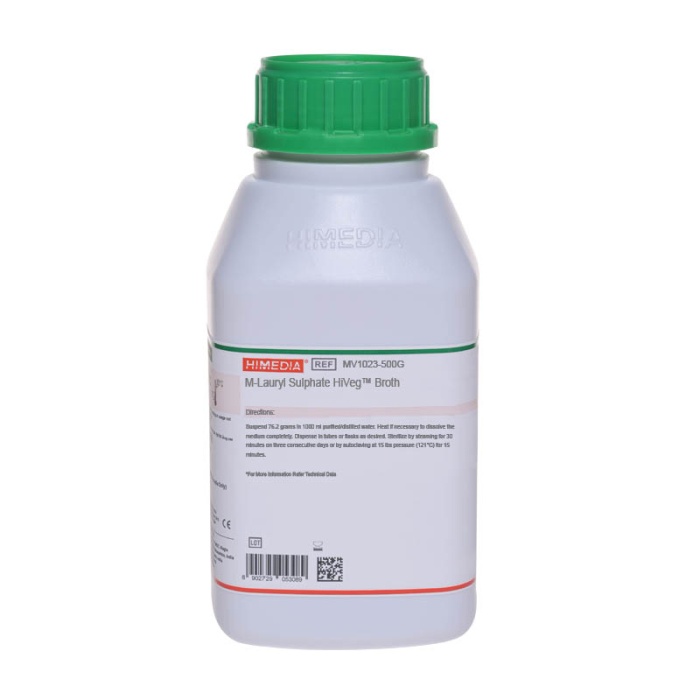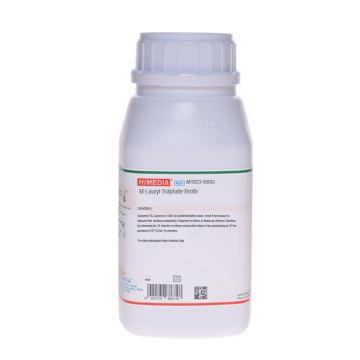 Your enquiry has been submitted
Your enquiry has been submitted
M-Lauryl Sulphate Broth
M-Lauryl Sulphate Broth is used for enumeration of Escherichia coli and coliforms in water, using membrane filter technique.
Composition**
Ingredients
| Ingredients | Gms/Litre |
|---|---|
| Peptic digest of animal tissue | 40.000 |
| Yeast extract | 6.000 |
| Lactose | 30.000 |
| Sodium lauryl sulphate | 1.000 |
| Phenol red | 0.200 |
Final pH (at 25°C): 7.4±0.2
**Formula adjusted, standardized to suit performance parameters
Directions
Suspend 77.2 grams in 1000 ml distilled water. Heat if necessary to dissolve the medium completely. Dispense as desired and sterilize by steaming for 30 minutes on three consecutive days or by autoclaving at 15 lbs pressure (121°C) for 15 minutes.
Principle And Interpretation
Burman (1) substituted bile salts with teepol in Membrane Enriched Teepol Broth, the membrane filtration test medium used to detect coliform organisms in water. Membrane or M-Lauryl Sulphate Broth recommended (2, 3) is similar to M-Enriched Teepol Broth except teepol has been replaced by sodium lauryl sulphate. Sodium lauryl sulphate was found to be an adequate reproducible substitute. Recently ISO Committee (4) has recommended a slight modification (M1023I) of M-Lauryl Sulphate Broth for enumeration of coliforms in water. E. coli and coliform count should be made on separate samples of water. The volumes should be chosen so as the number of colonies on the membrane lies between 10 and 100. The water samples are filtered through sterile membrane filter and then placed face upward on an absorbent pad saturated with M-Lauryl Sulphate Broth. The membranes should be incubated in a container which does not allow evaporation to occur. Water-tight metal containers placed in an accurate water bath are required for incubation of membranes at 44°C. Burman (5) recommended the following incubation temperatures and durations.
Unchlorinated waters:
- Coliform organisms: 4 hours at 30°C followed by 14 hours at 35°C
- Escherichia coli: 4 hours at 30°C followed by 14 hours at 44°C
Non-chlorinated organisms benefit from 4 hours incubation at 30°C but chlorinated organisms require 6 hours incubation at 25°C. After incubation, yellow colonies are formed which should be confirmed further. No colonies should be assumed on appearance of as nil count. On appearance of small colonies of an intermediate colour, the membrane should be returned for incubation for full period. E. coli forms yellow coloured colonies on membranes when incubated at 44°C. Subculture to Lactose Broth (M1003) and Tryptone water (M463I) to confirm gas and indole production respectively after 24 hours incubation at 44°C. Coliform organisms which give yellow colonies on membranes incubated at 35-37°C should be subcultured in Lactose Broth (M1003). This can be incubated at 37°C for 48 hours to check gas production.
Quality Control
Appearance Light yellow to pink homogeneous free flowing powder
Colour and Clarity of prepared medium Red coloured clear solution without any precipitate
Reaction Reaction of 7.72% w/v aqueous solution at 25°C. pH: 7.4±0.2
pH
7.20-7.60
Cultural Response
M10231: Cultural characteristics observed after an incubation at 18 hours at different temperatures
| Organism | Inoculum (CFU) | Growth on membrane(at 35-37°C) | Colour of Colony on Membrane | Growth on membrane (at 43-45°C) | Colour of Colony on Membrane |
|---|---|---|---|---|---|
| Escherichia coli ATCC 25922 | 50-100 | luxuriant | yellow | luxuriant | yellow |
| Enterobacter aerogenes ATCC 13048 | 50-100 | luxuriant | yellow | inhibited |
Storage and Shelf Life
Store below 30°C in tightly closed container and the prepared medium at 2 - 8°C. Use before expiry date on the label.
Reference
- Burman N. P., 1967, Proc. Soc. Wat. Treat. Exam., 16:40.
- Joint Committee of PHLS and the Standing Committee of Analysis, 1980, J. Hyg. Camb., 85:181.
- Stanfied G. and Irving T. E., 1981, Water Research, 15:469.
- International Organization for Standardization, 1990, Draft ISO/DIS: 9308-1.
- Burman N. P., 1967, Rec. Adv. in Bacteriological Examination of waters; C.H. Collins (Ed.), Butterworth, London.
| Product Name | M-Lauryl Sulphate Broth |
|---|---|
| SKU | M1023I |
| Product Type | Regular |
| Physical Form | Powder |
| Origin | Animal |
| Packaging type | HDPE |
| References | 1. Eaton A. D., Clesceri L. S. and Greenberg A. E., (Eds.), 1995, Standard Methods for the Examination of Water andWastewater, 19th Ed., American Public Health Association, Washington, D.C. |
| Customized Product Available | No |









